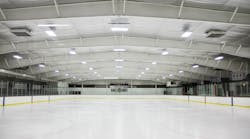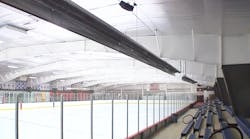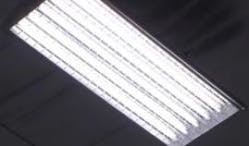Ice arenas offer significant climate control challenges, and represent some of the most energy-intensive buildings a city can own. The process of making ice takes a lot of energy as does keeping the ice at a consistently frozen temperature all while ensuring that cheering spectators remain comfortable without overheating active, sweating players.
The rinks, which are typically used day and night, year round, need to be able to maintain consistent and comfortable temperatures all while quickly adapting from conditioning a nearly vacant space to hosting capacity crowds.
The Hamilton Ice Arena at the Rocky River Recreation Center, located in western suburban Cleveland, serves the city’s residents including high school hockey players, school children and senior citizens, and hosts a regional hockey program that serves more than 400 players from Rocky River and surrounding communities.
Watch a video about this project by visiting Rocky River improvements expected to save up to 20 percent annually
The ice rink and arena needed attention. Lighting dated back to the original rink construction completed in 1970. Illumination proved so poor that any newly installed lights left a “halo” on the rink. Players found it difficult to see the puck – and the lack of illumination made it even more challenging for spectators to follow the puck. Inconsistent heating left warm and cool spots within the arena and warmth over the rink made events uncomfortable for the players who needed less heating to counteract their high activity levels.
City Needed First-class Rink
City leaders wanted to offer a first-class rink that would meet current users’ needs and even draw new residents to the city. Rocky River competes with surrounding communities to maintain and expand its population. Improving the lighting and the heating/ventilation could generate significant energy savings which could then be invested back into making improvements in the rink.
Facilities Audit Finds Opportunities for Improvement
City leaders worked with Gardiner Trane, based in Solon, OH, to analyze a city-wide facilities energy audit which identified potential for savings throughout city buildings. Given the prospective savings that could be gained from improving the lighting and heating, ventilation and air conditioning (HVAC) in the ice arena and the significant role that the arena plays in the lives of the city’s current and potential residents, city leaders decided to update the Hamilton Ice Arena first.
A "shared savings" plan was used to help the city avoid up-front costs.
"Rocky River is like a lot of communities in the state of Ohio; tax dollars are really tight, and they operate on a really tight budget," says John Scott, Gardiner Trane vertical market leader for government. We will do an energy savings project, and all the capital costs in it will be borne by Gardiner Trane. In a three-year agreement, we will share all the savings from three years."
Upgraded Lighting
Major improvements included replacing 45 metal halide light fixtures using a six-tube fixture with GE T5 lights in the arena to increase the clarity and quality of light and save energy. The new GE lights offer double the life expectancy of the previous lights while requiring an investment of nearly 50% less per bulb. More importantly, the new bulbs transformed the ability for both players and spectators to see in the arena, removing halos and dark spots and leaving the rink atmosphere clear, clean and crisp in appearance. The profile of the new lighting fixtures, which is located closer to the ceiling, eliminates the puck interference that they experienced with the old fixtures.
“These lights are absolutely fabulous,” says Christopher Mehling, recreation director for the City of Rocky River. “They’ve brightened the whole arena and given it a whole new look overall – it’s just clean. Previously, the rink atmosphere was so dark that people entering the rink commented on it. Now when anyone comes into the arena, the first thing they comment on is how bright the facility looks and how fabulous it looks overall.”
Radiant Heaters Improve Building Comfort
Improvements also included installing four efficient gas-fired radiant heaters, primarily over the stands and the area where residents put on their skates for the rink’s “all skate” sessions. The previous heating system left the area over the rink uncomfortably warm for skaters and players. The new system greatly improved the comfort for the ice rink participants and spectators.
Monitors Increase Building Efficiency
To properly ventilate the space, two carbon dioxide (CO2) sensors were added to monitor CO2 levels in the space to indicate when to ventilate. When the sensor indicates the need for ventilation, outside air is increased as needed.
Separate controls allow the rink facilities team ─ and Gardiner Trane at the city’s request ─ to remotely control the gas-fired radiant heaters and ventilation. Operation of the heaters is reduced during unoccupied times. The web-based monitoring system, which tracks and controls operation of the gas-fired heating ventilation units, includes remote access and local overrides.
City leaders anticipate that the improvements will save up to 20% in annual energy costs while improving lighting for players, skaters and spectators and occupant comfort for all.
Civic Center Improvements Next for City
Administrators are so pleased with the results at the recreation center that they plan to undertake similar improvements in the city’s civic center, another key building that serves both local residents and surrounding communities.
For more information about high performance buildings, visit www.trane.com/highperformancebuildings.













